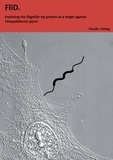FliD
Exploring the flagellar tip protein as a target against Campylobacter jejuni

Freitag, Claudia
- Promoter:
- Prof.dr. J.P.M. (Jos) van Putten
- Research group:
- Putten
- Date:
- November 24, 2017
- Time:
- 10:30 h
Summary
Campylobacter jejuni is most common bacterial agent causing human diarrhea. Symptoms can range from mild colitis to severe bloody enteritis with abdominal cramping. Chickens represent the main reservoir of C. jejuni and contaminated meat products are an important source of human infection. In order to reduce human infection, measures to either limit C. jejuni colonization of the chicken gut or the development of a vaccine are under investigation. Both solutions require detailed knowledge of the behavior of the bacterium in the complex setting of the intestine. The present study was designed to understand the initial molecular interaction of C. jejuni with its host and to investigate natural infection intervention mechanisms. Adhesion to host cells is often the first step during infection, yet the role of the few characterized C. jejuni adhesins and their corresponding receptors is still disputed. However, it is generally accepted that the bacterial flagella are essential for bacterial colonization and infection. C. jejuni carries one single flagellum at each pole that enables bacterial motility. The work described in this thesis focused on the initial interaction of C. jejuni flagella with host cells. In the study, we discovered that the flagellar tip protein FliD binds to the cell surface, acting as an early attachment factor. Moreover, we identified heparan sulfate glycosaminoglycans as the binding partner of FliD at the host cell surface. The region in FliD that is responsible for the interaction was mapped to the central part of the FliD protein. The potential significance of this discovery became evident when we found that anti-FliD antibodies in the egg yolk can block the binding of FliD to cells. These maternal antibodies may thus contribute to the documented protection of chickens against C. jejuni colonization within the first two weeks of age. The interaction of the C. jejuni FliD with host cells also led to the discovery that milk contains a natural inhibitor of FliD binding. We identified milk caseins as the inhibitory compound. Lastly, by employing the availability of structural data of FliD proteins of several other bacterial species, we predicted the structure of FliD of C. jejuni in order to identify patches with cell binding potential. This work also revealed that the flagellar tip proteins of different species display bacterial adhesion properties as well, suggesting a common mechanism of FliD-host cell interaction. Together, our findings shed light on how C. jejuni and perhaps other bacterial species exploit their flagella tip protein for initial contact with the host and that maternal antibodies and milk constituents may be valuable natural sources to prevent this interaction.